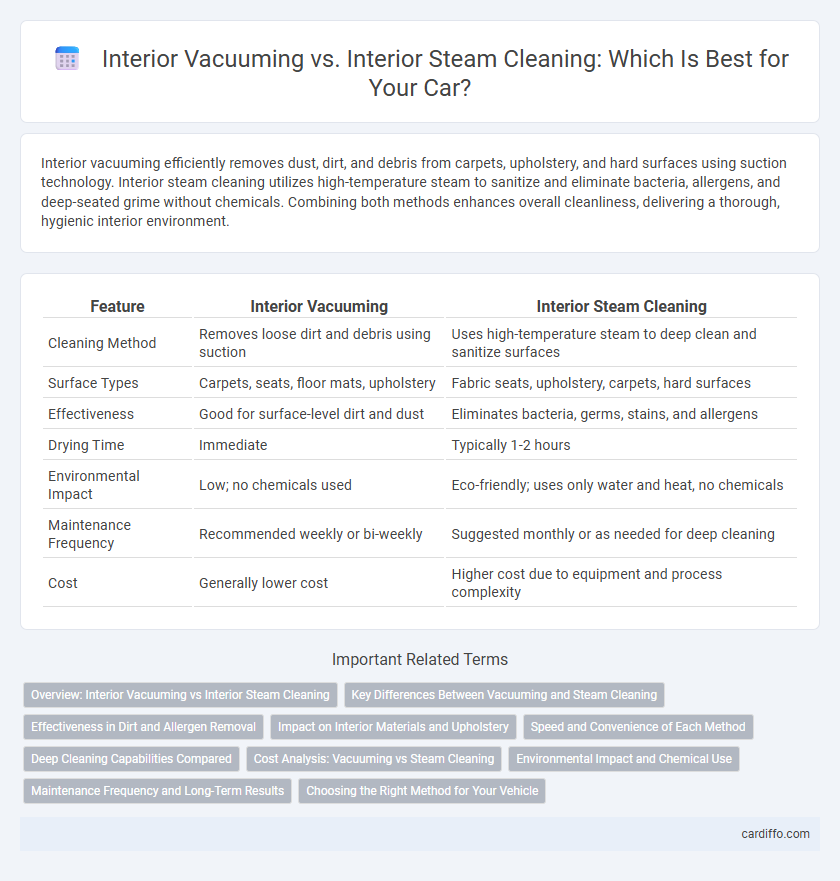Interior vacuuming efficiently removes dust, dirt, and debris from carpets, upholstery, and hard surfaces using suction technology. Interior steam cleaning utilizes high-temperature steam to sanitize and eliminate bacteria, allergens, and deep-seated grime without chemicals. Combining both methods enhances overall cleanliness, delivering a thorough, hygienic interior environment.
Table of Comparison
| Feature | Interior Vacuuming | Interior Steam Cleaning |
|---|---|---|
| Cleaning Method | Removes loose dirt and debris using suction | Uses high-temperature steam to deep clean and sanitize surfaces |
| Surface Types | Carpets, seats, floor mats, upholstery | Fabric seats, upholstery, carpets, hard surfaces |
| Effectiveness | Good for surface-level dirt and dust | Eliminates bacteria, germs, stains, and allergens |
| Drying Time | Immediate | Typically 1-2 hours |
| Environmental Impact | Low; no chemicals used | Eco-friendly; uses only water and heat, no chemicals |
| Maintenance Frequency | Recommended weekly or bi-weekly | Suggested monthly or as needed for deep cleaning |
| Cost | Generally lower cost | Higher cost due to equipment and process complexity |
Overview: Interior Vacuuming vs Interior Steam Cleaning
Interior vacuuming efficiently removes loose dirt, dust, and debris from carpet fibers and upholstery surfaces, helping maintain cleanliness without moisture. Interior steam cleaning employs high-temperature steam to penetrate deep into fabrics and hard-to-reach areas, effectively sanitizing and eliminating bacteria, allergens, and stubborn stains. Choosing between interior vacuuming and steam cleaning depends on the level of soil, fabric type, and desired sanitation results.
Key Differences Between Vacuuming and Steam Cleaning
Interior vacuuming primarily removes loose dirt, dust, and debris from surfaces using suction, making it ideal for carpets, upholstery, and hard floors. Interior steam cleaning employs high-temperature steam to sanitize and deep clean surfaces by breaking down grime, killing bacteria, and removing stains without chemicals. Vacuuming is a dry cleaning method targeting surface particles, while steam cleaning offers a wetter, more thorough disinfection and stain removal, especially useful for fabrics and tiles.
Effectiveness in Dirt and Allergen Removal
Interior vacuuming effectively removes surface dirt, dust, and larger debris from carpets and upholstery, capturing allergens such as pet dander and dust mites, but it may leave embedded particles deep within fibers. Interior steam cleaning uses hot steam to penetrate fabric fibers, breaking down dirt, grime, and bacteria, providing a deeper clean that eliminates allergens and kills dust mites without chemical residues. Combining both methods enhances overall cleanliness by ensuring surface debris is removed before steam sanitizes and refreshes interior surfaces.
Impact on Interior Materials and Upholstery
Interior vacuuming effectively removes loose dirt, dust, and debris from upholstery and interior materials without causing abrasion or moisture damage, preserving fabric integrity and preventing mold growth. Interior steam cleaning penetrates deep into fibers, eliminating stubborn stains and bacteria but requires careful control of temperature and moisture to avoid warping delicate surfaces or shrinking fabrics. Both methods enhance interior cleanliness, but choosing between vacuuming and steam cleaning depends on material sensitivity and the level of soil, with vacuuming preferred for routine maintenance and steam cleaning for intensive deep cleaning.
Speed and Convenience of Each Method
Interior vacuuming offers a fast and convenient cleaning method by quickly removing dust and debris from surfaces without requiring drying time. Interior steam cleaning, while slightly slower due to moisture application and necessary drying, provides deeper sanitization and eliminates bacteria and allergens effectively. The choice between vacuuming and steam cleaning depends on the need for speed versus the desire for thorough, chemical-free disinfection.
Deep Cleaning Capabilities Compared
Interior vacuuming effectively removes surface dust, dirt, and loose debris from upholstery and carpets but often misses deeply embedded allergens and bacteria. Interior steam cleaning employs high-temperature steam to penetrate fabric fibers, breaking down stubborn stains, killing germs, and eliminating deep-seated contaminants. Steam cleaning offers superior deep cleaning capabilities by sanitizing and refreshing interiors beyond the reach of traditional vacuuming methods.
Cost Analysis: Vacuuming vs Steam Cleaning
Interior vacuuming typically incurs lower upfront and operational costs due to its reliance on electricity and standard vacuum bags or filters, making it a budget-friendly option for regular maintenance. Steam cleaning, while often costing more initially due to specialized equipment and higher energy consumption, provides deeper sanitization and can reduce the frequency of cleaning sessions, potentially offsetting its higher price over time. Cost analysis must factor in equipment lifespan, cleaning efficiency, and the desired level of interior hygiene to determine the most cost-effective method.
Environmental Impact and Chemical Use
Interior vacuuming minimizes environmental impact by avoiding water use and chemical detergents, relying solely on suction to remove dust and debris. Interior steam cleaning reduces reliance on harsh chemicals through high-temperature steam that effectively sanitizes surfaces, but it consumes more energy and water compared to vacuuming. Choosing vacuuming benefits eco-conscious settings by conserving resources, while steam cleaning offers chemical-free sanitation with higher energy demands.
Maintenance Frequency and Long-Term Results
Interior vacuuming requires frequent sessions, often weekly, to remove surface dust and debris efficiently, supporting regular maintenance routines. Interior steam cleaning, though performed less often--typically quarterly or biannually--delivers deeper sanitation by eliminating bacteria, allergens, and embedded dirt, contributing to healthier environments. Long-term results favor steam cleaning for sustaining material integrity and preventing buildup, while vacuuming primarily maintains daily cleanliness without addressing microbial contaminants.
Choosing the Right Method for Your Vehicle
Interior vacuuming effectively removes loose debris, dust, and pet hair from upholstery and carpets, making it ideal for routine maintenance and allergy control. Interior steam cleaning penetrates fabric fibers and hard surfaces to eliminate stubborn stains, bacteria, and odors, offering a deep sanitation especially beneficial for vehicles exposed to spills or heavy use. Selecting the right method depends on the vehicle's condition, level of soiling, and desired cleanliness, with vacuuming suitable for regular upkeep and steam cleaning recommended for thorough disinfection and stain removal.
Interior vacuuming vs Interior steam cleaning Infographic

 cardiffo.com
cardiffo.com